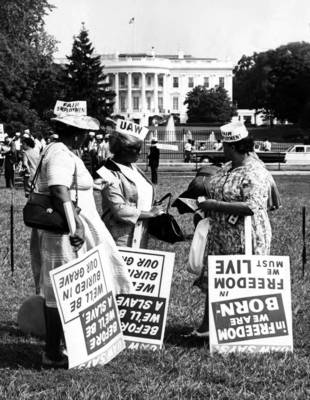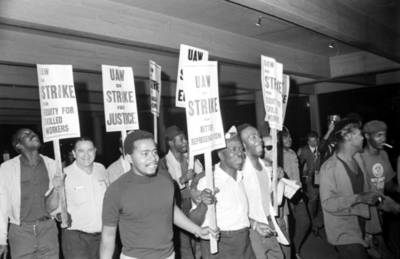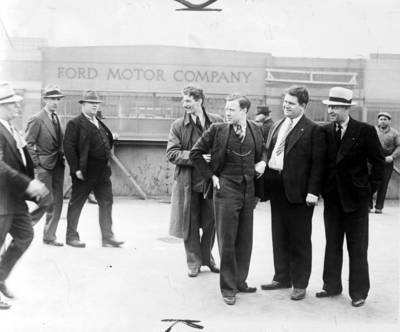United Auto Workers - Integrated Curriculum Plan
Standards
4 – P3.3.1 Compose a brief essay expressing a position on a public policy issue in the United States and justify the position with a reasoned argument
4 – P3.1.2 Use graphic data and other sources to analyze information about a public issue in the United States and evaluate alternative resolutions.
4 – C5.0.3 Describe ways in which people can work together to promote the values and principles of American democracy.
4 – H3.0.6 Use a variety of primary and secondary sources to construct a historical narrative about the beginnings of the automobile industry and the labor movement in Michigan.
CCSS.ELA-LITERACY.W.4.5 -With guidance and support from peers and adults, develop and strengthen writing as needed by planning, revising, and editing.
Learning Objectives
Students will use primary and secondary sources to gain a deeper understanding of the working conditions most Americans faced in industrial jobs.
Students will be able to write at least three paragraphs with introduction and conclusion statements that employ persuasive writing to express the importance of the UAW.
Students will use their knowledge of the UAW’s history and current labor unions to develop informed questions for a UAW representative.
Students will be able to use their questions to gain deeper understanding into the values and purpose of organized unions.
Students will retell at least five key events from the UAW’s history with at least one sentence and illustration for each event.
Essential Questions:
-
What led to the formation of the UAW?
-
Why did the founders feel the UAW was necessary?
-
What sources help you form your own opinions about this topic?
Day 1: Introduction and timeline photos
Students will be asked what they already know about the United Auto Workers (UAW) to assess students prior knowledge. Students will then be introduced to a contemporary issue involving the UAW (Recent "Stand Up" Strike).
Students will be shown four pictures of the UAW’s actions (see below).
Students will be asked to place archival documents from key events that occured in the rise of the United Auto Workers in Detroit in chronological order. This assessment will be executed at both the beginning, as well as the end, of the unit plan.
Students will then be guided through analysis and discussion of the photograph’s significance.
Assessment
Students will be asked to consider the number of students in the class and how many times we would have to multiply that number to reach the same number of auto-workers that went on strike in the Flint sit-down strike.
As students are asked to put archival documents in chronological order, the teacher will informally complete a formative assessment to check students’ understanding at this point in time.
Day 2: Mapping events
Students will be guided through key events throughout history that led up to and followed the rise of the UAW in Detroit. Students' understanding will be deepened with questions about the working conditions that workers had to endure before the formation of the UAW.
Consider using a general timeline like what is available on Wikipedia and drawing out highlights.
Day 3: Write a Speech
Students will be instructed to write a speech detailing the impact of the UAW in their own words. Their use should draw on evidence from primary source documents and class discussions. Ask students to aim for 2 minute speeches.
Tell students they will have a chance to share this writing in spoken word in the end of the unit if this is the project they choose. Students will have time to edit their writing and practice their speech in the last few days of the unit.
Day 4: FIELD TRIP to Detroit Institute of Arts - Diego Rivera mural
Students will be introduced to the DIA’s Detroit Industry mural by Diego Rivera. They will be instructed to work in partners to look for a person in the mural to focus on, and they will draw and describe how they envision that person fitting into the labor industry.
Consider bringing worksheets for the students to organize their thoughts with questions such as
1. Who is your person?
2. What is their job?
3. What clues in the painting make you think so?
In order to facilitate later discussion, you might also ask students to circle the person they are discussing on an image of the mural printed on the back of their worksheet.
Day 5: Create character stories
Students will be asked to choose a character from the Diego Rivera mural at their field trip to the Detroit Institute of Art. Students will be asked to write a backstory for their chosen character. Rather than making assumptions about the figures in the paintings, ask them to connect their stories to pieces of evidence, whether from previous class discussions or from searches online (using grade-level appropriate search engines).
Ask students to illustrate that person's life through drawings and captions.
Day 6: Research questions for UAW representative
Students will be asked to research and compare working conditions in the auto factories in the USA before the formation of the UAW (in 1935) and now, as well as the current working conditions of auto-workers in other parts of the world today.
Students might consult sources like news stories from the 1930s as well as news stories about modern-day contract negotiations to compare and contrast what workers fought for at different times.
Day 7: UAW representative class visit
Students will use what they have learned so far in the unit to create an informed question about the UAW’s history and what the UAW does today.
Note: you will need to plan ahead to schedule a visitor! UAW representatives from a local union in your area might be a good place to start. You might start by seeking out a representative of the education department.
Day 8: Work on key events books
Students will be asked to create a book outlining the chronological events of the UAW’s formation, using written ideas and pictures to represent events. This does not need to be an exhaustive book (think 8 pages, including images). Students may draw on any sources from past parts of the unit or continue researching.
Day 9: Peer review and workshop/refine creative works to prepare for showcase
Students will work in groups of 2-3 to peer review each others' draft books from day 8. Start the lesson by explaining that feedback should be constructive and clear. Consider using guided questions displayed on the board or projector such as:
What did you like about the book?
Did anything confuse you as you read the book?
What would you suggest changing about the book?
Day 10: Closing lesson and creative works showcase
The last lesson in the unit will be a showcase opportunity for students to share their creative projects with their classroom community with the option to invite broader community networks (e.g. the rest of the school, families, etc…)
Ask students to choose their favorite of the projects for this unit and share it with the audience. Make sure to thank all the students and clap for all their hard work!




